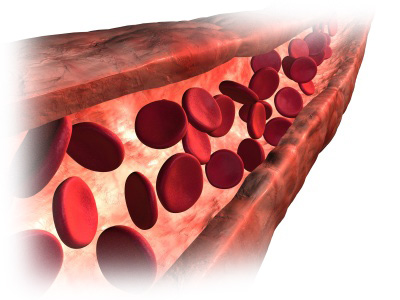As the heart beats, it pumps blood through a system of blood vessels, called the circulatory system. The vessels are elastic tubes that carry blood to every part of the body,
- Arteries carry blood away from the heart.
- Veins return blood back to the heart.
Vascular Disease includes any condition that affects your circulatory system, such as peripheral artery disease. This ranges from diseases of your arteries, veins and lymph vessels to blood disorders that affect circulation. The following are conditions that fall under the category of "Vascular Disease":
 Peripheral Artery Disease Peripheral Artery Disease
Like the blood vessels of the heart (coronary arteries), your peripheral arteries (blood vessels outside your heart) also may develop atherosclerosis, the build-up of fat and cholesterol deposits, called plaque, on the inside walls. Over time, the build-up narrows the artery. Eventually the narrowed artery causes less blood to flow, and a condition called ischemia can occur. Ischemia is inadequate blood flow to the body's tissue.
- A blockage in the coronary arteries can cause symptoms of chest pain (angina) or a heart attack.
- A blockage in the carotid arteries (the arteries supplying the brain) can lead to a transient ischemic attack (TIA) or stroke
- A blockage in the legs can lead to leg pain or cramps with activity (claudication), changes in skin color, sores or ulcers and feeling tired in the legs. Total loss of circulation can lead to gangrene and loss of a limb.
- A blockage in the renal arteries can cause renal artery disease (stenosis). The symptoms include uncontrolled hypertension (high blood pressure), congestive heart failure, and abnormal kidney function.
Aneurysm
An aneurysm is an abnormal bulge in the wall of a blood vessel. Aneurysms can form in any blood vessel, but they occur most commonly in the aorta (aortic aneurysm) which is the main blood vessel leaving the heart:
- Thoracic aortic aneurysm (part of aorta in the chest)
- Abdominal aortic aneurysm - include one or more of the following:
- Suprarenal aneurysm (involving the arteries above the kidneys)
- Juxtarenal aneurysm (involving the main renal arteries)
- Infrarenal aneurysm (involving the arteries below the kidneys)
- Small aneurysms generally pose no threat. However, one is at increased risk for:
- Atherosclerotic plaque (fat and calcium deposits) formation at the site of the aneurysm
- A clot (thrombus) may form at the site and dislodge
- Increase in the aneurysm size, causing it to press on other organs, causing pain
- Aneurysm rupture - because the artery wall thins at this spot, it is fragile and may burst under stress. A sudden rupture of an aortic aneurysm may be life threatening
Renal Artery Disease
Renal artery disease is most commonly caused by atherosclerosis of the renal arteries (see above). It occurs in people with generalized vascular disease. Less often, renal artery disease can be caused by fibromuscular dysplasia, a congenital (present at birth) abnormal development of the tissue that makes up the renal arteries. This type of renal artery disease occurs in younger age groups.
Raynaud's Phenomenon (also called Raynaud's Disease or Raynaud's Syndrome)
Raynaud's Phenomenon consists of spasms of the small arteries of the fingers, and sometimes, the toes, brought on by exposure to cold or excitement. Certain occupational exposures bring on Raynaud's. The episodes produce temporary lack of blood supply to the area, causing the skin to appear white or bluish and cold or numb. In some cases, the symptoms of Raynaud's may be related to underlying connective tissue disorders (i.e., lupus, rheumatoid arthritis, scleroderma).
Buerger's Disease
 Buerger's Disease most commonly affects the small and medium sized arteries, veins, and nerves. Although the cause is unknown, there is a strong association with tobacco use or exposure. The arteries of the arms and legs become narrowed or blocked, causing lack of blood supply (ischemia) to the fingers, hands, toes and feet. Pain occurs in the arms, hands, and more frequently the legs and feet, even at rest. With severe blockages, the tissue may die (gangrene), requiring amputation of the fingers and toes. Buerger's Disease most commonly affects the small and medium sized arteries, veins, and nerves. Although the cause is unknown, there is a strong association with tobacco use or exposure. The arteries of the arms and legs become narrowed or blocked, causing lack of blood supply (ischemia) to the fingers, hands, toes and feet. Pain occurs in the arms, hands, and more frequently the legs and feet, even at rest. With severe blockages, the tissue may die (gangrene), requiring amputation of the fingers and toes.
Superficial vein inflammation and symptoms of Raynaud's occur commonly in patients with Buerger's Disease.
Peripheral Venous Disease
Veins are flexible, hollow tubes with flaps inside, called valves. When your muscles contract, the valves open, and blood moves through the veins. When your muscles relax, the valves close, keeping blood flowing in one direction through the veins.
If the valves inside your veins become damaged, the valves may not close completely. This allows blood to flow in both directions. When your muscles relax, the valves inside the damaged vein(s) will not be able to hold the blood. This can cause pooling of blood or swelling in the veins. The veins bulge and appear as ropes under the skin. The blood begins to move more slowly through the veins, it may stick to the sides of the vessel walls and blood clots can form.
Varicose Veins
Varicose veins are bulging, swollen, purple, ropy veins, seen just under your skin, caused by damaged valves within the veins. They are more common in women than men and they often run in families. They can also be caused by pregnancy, being severely overweight, or standing for long periods of time. The symptoms include:
- Bulging, swollen, purple, ropy, veins seen under the skin
- Spider veins - small red or purple bursts on your knees, calves, or thighs, caused by swollen capillaries (small blood vessels)
- Aching, stinging, or swelling of the legs at the end of the day
Venous Blood Clots
Blood clots in the veins are usually caused by:
- Long bedrest and/or immobility
- Damage to veins from injury or infection
- Damage to the valves in the vein, causing pooling near the valve flaps
- Pregnancy and hormones (such as estrogen or birth control pills)
- Genetic disorders
- Conditions causing slowed blood flow or thicker blood, such as inflammatory bowel disease, congestive heart failure (CHF), or certain tumors
Deep vein thrombosis (DVT) is a blood clot occurring in a deep vein.
Pulmonary embolism is a blood clot that breaks loose from a vein and travels to the lungs.
Chronic Venous Insufficiency
Chronic venous insufficiency (CVI) occurs when damaged vein valves or a DVT causes long-term pooling of blood and swelling in the legs. If uncontrolled, fluid will leak into the surrounding tissues in the ankles and feet, and may eventually cause skin breakdown and ulceration.
 Other vascular conditions include: Other vascular conditions include:
Blood Clotting Disorders
Blood clotting disorders are disorders that make the blood more likely to form blood clots (hypercoagulable) in the arteries and veins. These conditions may be inherited (congenital, occurring at birth) or acquired during life and include:
- Elevated levels of factors in the blood which cause blood to clot (fibrinogen, factor 8, prothrombin)
- Deficiency of natural anticoagulant (blood-thinning) proteins (antithrombin, protein C, protein S
- Elevated blood counts
- Abnormal Fibrinolysis (the breakdown of fibrin)
- Abnormal changes in the lining of the blood vessels (endothelium)
Lymphedema
The lymphatic system is a circulatory system that includes an extensive network of lymph vessels and lymph nodes. The lymphatic system helps coordinate the immune system's function to protect the body from foreign substances. Lymphedema is an abnormal build-up of fluid that causes swelling, most often in the arms or legs. Lymphedema develops when lymph vessels or lymph nodes are missing, impaired, damaged or removed. Primary lymphedema is rare and is caused by the absence of certain lymph vessels at birth, or it may be caused by abnormalities in the lymphatic vessels. Secondary lymphedema occurs as a result of a blockage or interruption that alters the lymphatic system. Secondary lymphedema can develop from an infection, malignancy, surgery, scar tissue formation, trauma, deep vein thrombosis (DVT), radiation or other cancer treatment.
Section of Vascular Medicine
The Vascular Medicine physicians at the Miller Family Heart & Vascular Institute at Cleveland Clinic are specialists in the diagnosis and treatment of patients with vascular diseases. The Non-Invasive Laboratory includes state-of-the art computerized imaging equipment to assist in diagnosing vascular disease, without added discomfort to the patient.
The Vascular Intervention Program provides many options to treat vascular disease, while avoiding surgical procedures.
How to find a doctor if you have Carotid Artery Disease
Search by specialty or disease/condition, to find a Miller Family Heart & Vascular Institute physician who treats vascular disease.
|